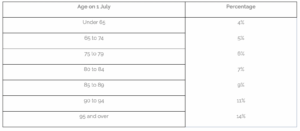Many retirees use their superannuation to commence a pension that pays income at regular intervals. The most common type of pension is an account-based pension. These are also sometimes referred to by their former name – allocated pensions.
Account-based pensions are a very tax-effective way of setting up super to provide a regular flow of income in retirement.
However, like anything to do with super, there are some hurdles that need to be cleared to ensure the efficient and compliant operation of a pension account.
Today, I will focus on the amount of income that needs to be drawn each financial year.
For an account-based pension to receive optimal tax treatment, a minimum amount of income needs to be drawn each year. This is based on a formula that varies with age.
When a pension first commences to be paid, and on 1 July each year thereafter, a percentage factor is applied to the balance of the pension account. The result is the minimum income that needs to be paid from the pension account in the coming year.
The following table sets out the current minimum percentages:

In simple terms, a 72-year-old with a pension account balance of $340,000 on 1 July 2023 will need to draw a minimum income of $17,000 in the 2023-24 financial year.
The maximum income is not capped, except for pension paid under transition to retirement rules where the pension income is capped at a maximum of 10% of the account balance each year.
If a pension commences part way through a financial year (i.e. other than on 1 July) the minimum income that is required to be drawn is pro-rated for the number of days in the financial year the pension is in force.
Taking our earlier example of a 72-year-old, if their pension commenced on 1 September 2023, the minimum income they will need to draw in 2023-24 is $17,000 x 303/365, or $14,112.
As a result of the economic turmoil that accompanied the recent global pandemic, the government reduced the minimum income to be drawn from an account-based pension (and certain other types of superannuation income stream) by 50% for the 2019-20, 2020-21, 2021-22 and 2022-23 financial years. Therefore, during these periods, a person aged between 65 and 74 only needed to draw an income of 2½% of their account balance to satisfy the prescribed minimum.
For any readers that had taken advantage of the lower minimum income requirement for the past 4 financial years, the discount was discontinued from 1 July 2023. Therefore, if you find you are being paid more income from your account-based pension than you need, it would be a good time to speak with a financial planner and discover the options that may be available to you.
By way of example, if you have been receiving income from your pension account of (say) $30,000 and this had been adequate for topping up your income needs, now having to draw an income of $60,000 may be more than needed. One option, particularly for many people under the age of 75, might be to simply re-contribute the excess income back into superannuation as a non-concessional contribution. However, before implementing specific strategies, seek appropriate advice.

